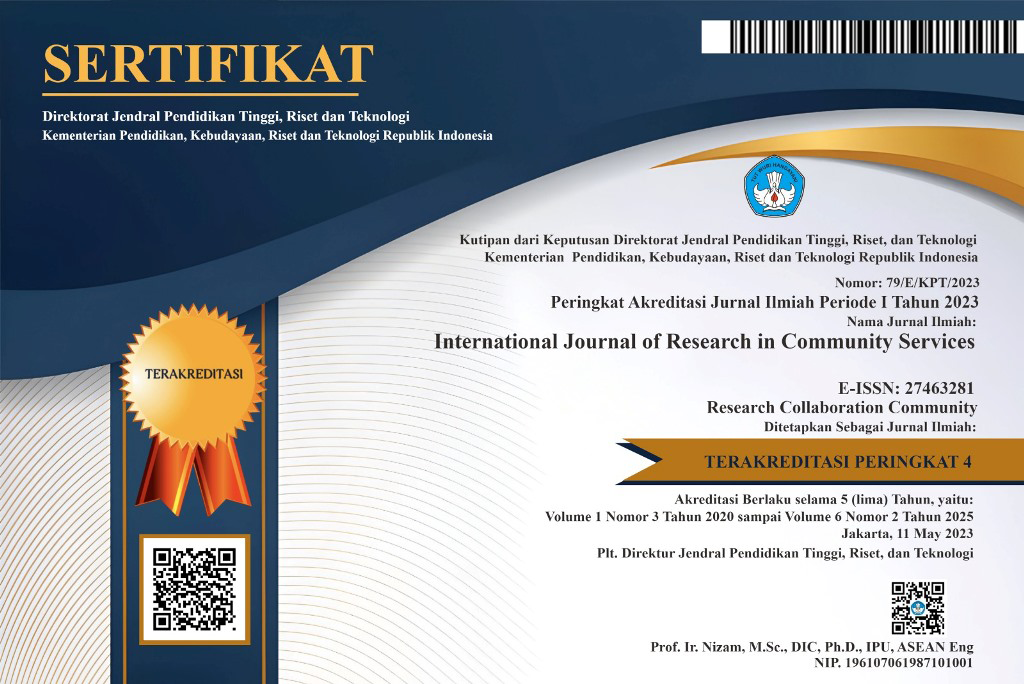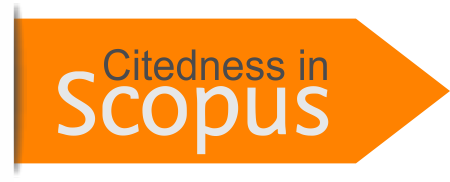Author Guidelines
International Journal of Research in Community Services (IJRCS)
IJRCS Starting from January 2020, all articles submitted to the IJRCS must be in English. Editorial Board of the IJRCS is at Jl. Riung Ampuh No. 3, Riung Bandung, Kota Bandung 40295, Jawa Barat, Indonesia For Information please email: ijrcs.rescollacomm@gmail.com
Articles written in English in essay format. Article titles printed in first capital letters are placed in the middle of the article in Times New Roman, 17 points. Articles written are not less than 5000 words and no more than 7000 words. The name of the author of the article is registered without an academic degree, along with the name and address of the institution of origin, and is placed under the title of the article. In the case of a script written by a team, the editor is linked to the main author. The author must enter an email. Articles written for the IJRCS in the form of research results (empirical / original articles)
Article Writing Guidelines and templates can be downloaded at the following address:
• Article Writing Templates and Guidelines in PDF (.pdf)
• Article Writing Templates and Guidelines in DOC (.doc)
Research Articles
The research article is the original article of research results in the Aim and Scope IJRCS The format of the research article consists of TITLE pages (in English) articles, Abstract (in English), Introduction, Material and Method, Results and Discussion , Conclusions,Acknowledgments (if any), and References
General instructions
To avoid duplication, IJRCS does not accept articles that have been published or are being sent to other journals, which must be proven by signing a statement that the manuscript was not sent or processed in another journal. The author must ensure that all other authors have agreed to publish in the IJRCS. If an article which has been published in the IJRCS is found to be published by another journal, IJRCS will announce its revocation in the next issue of the journal. All articles will be discussed by experts from the appropriate field (peer review) and also by the editorial board. Articles that need to be repaired are returned to the author. Research articles must obtain approval from the ethics committee or consider ethical aspects of the research that can be accounted for.
Article Writing
The article to be sent must be an article typed in Times New Roman with a size of 11 points on A4 paper with 1 space with a margin of 1,3 cm on the left and right, and 1,33 cm on the top and bottom. your article must not be less than 5000 words and may not be more than 7000 words. All pages must be numbered consecutively from the title page to the last page (see journal template). Articles will be published in US English.
TITLE PAGE
The title page contains the title of the article, the full author's name (without title). Author Institution Address written in full, and e-mail address (first author). The title of the article must be concise and clear. The English title cannot be more than 15 words.
Abstract
The abstract should summarize the problem, objective, method, result, and conclusions of the paper in less than 200-300 words. It should not contain any references or displayed equations. Typeset the abstract in 10 pt Times Roman. A maximum of 4-6 key words or phrases must be given that will be useful for retrieval and indexing. The key words must be separated by commas and should not include acronyms.
Keywords: Mathematics, instructions for authors, manuscript template
1. Introduction
The text is to be typeset in 11 pt Times Roman, single spaced. The Introduction should argue the case for the study, outlining only essential background, and should not include the findings or the conclusions. It should not be a review of the subject area, but should finish with a clear statement of the question being addressed.
2. Materials and Methods
2.1. Materials
Materialas icluding: object, location, data & informations, and tolls used in data analysis.
2.2. Methods
Methods include: the stages and formulas that are used in data analysis, arranged sequentially step by step.
2.2.1. Structure
Research articles should be divided into the sections listed below. Principal sections should be numbered consecutively (1. Introduction, 2.Materials and methods, etc.)and subsections should be numbered 1.1., 1.2., etc. Do not number the Acknowledgements or References sections.
Manuscripts must be written in English. Contributors who are not native English speakers are strongly advised to ensure that a colleague fluent in the English language or a professional language editor has reviewed their manuscript. Concise English without jargon should be used. Repetitive use of long sentences and passive voice should be avoided. It is strongly recommended that the text be run through computer spelling and grammar programs. Either British or American spelling is acceptable but must be consistent throughout.
2.2.2. Formula / Equation
Insert common mathematical equiations or build up your own equations using a library of math symbols. Variables and parameters must be typed in italics, while symbols of vectors or matrices are typed upright and bolded. All formulas or equations to be used in subsequent analyzes, must be numbered in sequence, for example (1), (2), etc. For example as follows:
2.2.3. Tables
All tables should be numbered with Arabic numerals. Headings should be placed above tables, left justified. Leave one line space between the heading and the table. Only horizontal lines should be used within a table, to distinguish the column headings from the body of the table, and immediately above and below the table. Tables must be embedded into the text and not supplied separately. Below is an example which authors may find useful.
2.2.4. Construction of references
Organization and citation of the bibliography are made in American Psychological Association (APA) style. Some examples of how your references should be listed are given at the end of this template in the ‘References’ section, which will allow you to assemble your reference list according to the correct format and font size.
3. Results and Discussion
All figures should be numbered with Arabic numerals (1,2,...n). All photographs, schemas, graphs and diagrams are to be referred to as figures. Line drawings should be good quality scans or true electronic output. Low-quality scans are not acceptable. Figures must be embedded into the text and not supplied separately. Lettering and symbols should be clearly defined either in the caption or in a legend provided as part of the figure. Figure is center, as shown below and cited in the manuscript.
4. Conclussion
Explain what has been done, and draw conclusions in accordance with the objectives of the research that has been determined. The conclusions are delivered narratively, do not contain equations, tables, and figures.
Acknowledgments
Acknowledgments (if any) need to be delivered if there are institutions or individuals who have an important role to support the implementation of research and publications conducted.
References
The main references are international journals and proceedings. All references should be to the most pertinent and up-to-date sources. References are written in APA style. Please use a consistent format for references – see examples below (10pt):
Akgul, A., Calgan, H., Koyuncu, I., Pehlivan, I., & Istanbullu, A. (2016). Chaos-based engineering applications with a 3D chaotic system without equilibrium points. Nonlinear dynamics, 84(2), 481-495.
Alligood, K. T., Sauer, T. D. and Yorke, J. A. (1996). Chaos: An Introduction to Dynamical Systems. New York: Springer-Verlag.
Anishchenko, V. S., & Strelkova, G. I. (1997, August). Attractors of dynamical systems. In 1997 1st International Conference, Control of Oscillations and Chaos Proceedings (Cat. No. 97TH8329) (Vol. 3, pp. 498-503). IEEE.









